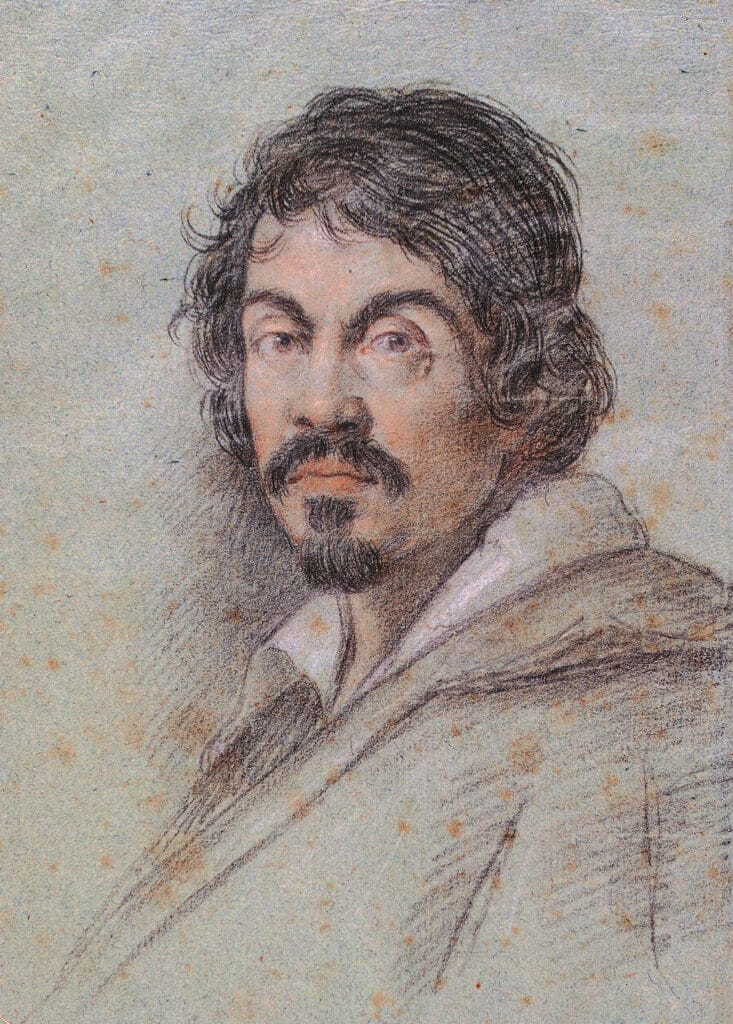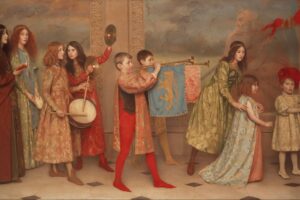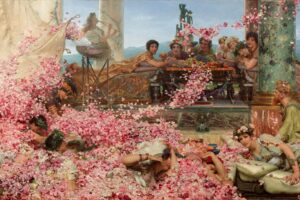Basket of Fruit
Caravaggio, c. 1599 – Baroque
At the height of the Baroque era, Caravaggio painted not a saint, nor a martyr, but a basket of fruit. This work, created around 1599, is a quiet marvel within his dramatic oeuvre—an unusual still life from an artist famed for religious intensity and theatrical chiaroscuro. But in this modest arrangement of apples, grapes, and leaves, we find a different kind of revelation: the truth of time and nature, honest and unvarnished.
The Scene Before Us
A woven basket sits on a flat ledge, heavy with ripened fruit. Every surface is lovingly rendered—the apple dimpled and rosy, the pear spotted and curling at the stem, the grapes translucent and softly decaying. A fig bursts open, revealing seeds inside. A leaf droops under its own weight. Nothing is idealized. Nothing is perfect. It is a portrait not of abundance, but of decline already beginning. The background is bare, almost ghostly, as if to say: this is all there is, and all there needs to be.
The Deeper Meaning
What appears at first to be a simple display of fruit is, in truth, a vanitas. The basket holds more than nourishment—it holds time, mortality, and beauty on the verge of loss. Caravaggio, always the realist, refused to flatter his subjects. Here he does the same with nature itself. This fruit will spoil. The leaves will wither. Even the basket seems slightly too small, its load precarious. In capturing the fruit so vividly, Caravaggio captures life’s fleeting glow.
A Moment Caught in Time
Baroque painting is often associated with drama, grandeur, and divine revelation. But this quiet still life offers a different kind of truth: the sacredness of the everyday, and the beauty found in what is aging, ordinary, and overlooked. Caravaggio gives us a sermon without saints, a meditation without words. The fruit will not last—but this moment does.
About Artist

Michelangelo Merisi da Caravaggio (1571–1610) was an Italian painter who single-handedly revolutionized painting and became a pivotal figure of the Baroque art movement. Living a tumultuous and often violent life, he created a body of work that was both intensely realistic and profoundly dramatic. His radical approach broke away from the idealized forms of the Renaissance and Mannerism, influencing a generation of artists known as the Caravaggisti.
Artistic Innovations
Caravaggio’s genius lies in his revolutionary use of a technique now known as tenebrism. This is an extreme form of chiaroscuro that uses a dramatic, single light source to create stark contrasts between light and dark, plunging the background into deep shadow while illuminating the figures in a theatrical spotlight. This technique heightens the emotional intensity of his scenes.
He also shocked his contemporaries with his radical naturalism. Unlike artists who used idealized models, Caravaggio often painted directly from life, using real people—including beggars, laborers, and prostitutes—as models for his saints and biblical figures. This brought a new, raw, and often shocking level of humanity to religious subjects. His paintings feel immediate and tangible, as if the sacred events are unfolding in a contemporary, ordinary setting.
Notable Works
- “The Calling of Saint Matthew” (1599–1600): This masterpiece, housed in the Contarelli Chapel in Rome, is a perfect example of his style. A single ray of light from an unseen source illuminates the tax collectors in a dark room as Christ, on the right, calls Matthew to follow him. The scene feels less like a historical event and more like a pivotal, everyday moment.
- “Basket of Fruit” (c. 1599): A truly groundbreaking painting, this is one of the earliest examples of a stand-alone still life in Italian art. Rather than depicting perfect, idealized fruit, Caravaggio rendered the basket’s contents with unflinching realism, including wormholes in an apple and a shriveled leaf. This work is often interpreted as a “memento mori,” a reminder of the transience of life and the inevitability of decay.
- “Judith Beheading Holofernes” (c. 1599): This intensely violent and psychological painting depicts the biblical heroine Judith in the act of beheading the Assyrian general. The scene is full of drama and emotion, with Judith’s face conveying a mixture of determination and revulsion.
- “The Supper at Emmaus” (1601): This work captures the moment the disciples recognize the resurrected Christ. The gestures are explosive, with one disciple’s arms outstretched in shock. The illusion of a meal on the table, with a basket of fruit seemingly about to topple off, brings the divine event into the viewer’s immediate space.
- “The Entombment of Christ” (1602–1603): Considered one of his greatest masterpieces, this painting focuses on the raw grief of those lowering Christ’s body into the tomb. The light, the weight of the bodies, and the powerful expressions of sorrow create a moving and unforgettable devotional image.



